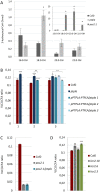Dual Fatty Acid Elongase Complex Interactions in Arabidopsis
- PMID: 27583779
- PMCID: PMC5008698
- DOI: 10.1371/journal.pone.0160631
Dual Fatty Acid Elongase Complex Interactions in Arabidopsis
Abstract
Very long chain fatty acids (VLCFAs) are involved in plant development and particularly in several cellular processes such as membrane trafficking, cell division and cell differentiation. However, the precise role of VLCFAs in these different cellular processes is still poorly understood in plants. In order to identify new factors associated with the biosynthesis or function of VLCFAs, a yeast multicopy suppressor screen was carried out in a yeast mutant strain defective for fatty acid elongation. Loss of function of the elongase 3 hydroxyacyl-CoA dehydratase PHS1 in yeast and PASTICCINO2 in plants prevents growth and induces cytokinesis defects. PROTEIN TYROSIN PHOSPHATASE-LIKE (PTPLA) previously characterized as an inactive dehydratase was able to restore yeast phs1 growth and VLCFAs elongation but not the plant pas2-1 defects. PTPLA interacted with elongase subunits in the Endoplasmic Reticulum (ER) and its absence induced the accumulation of 3-hydroxyacyl-CoA as expected from a dehydratase involved in fatty acid (FA) elongation. However, loss of PTPLA function increased VLCFA levels, an effect that was dependent on the presence of PAS2 indicating that PTPLA activity repressed FA elongation. The two dehydratases have specific expression profiles in the root with PAS2, mostly restricted to the endodermis, while PTPLA was confined in the vascular tissue and pericycle cells. Comparative ectopic expression of PTPLA and PAS2 in their respective domains confirmed the existence of two independent elongase complexes based on PAS2 or PTPLA dehydratase that are functionally interacting.
Conflict of interest statement
The authors have declared that no competing interests exist.
Figures






References
-
- Millar AA, Kunst L. Very-long-chain fatty acid biosynthesis is controlled through the expression and specificity of the condensing enzyme. Plant J. 1997;12: 121–131. - PubMed
-
- Blacklock BJ, Jaworski JG. Substrate specificity of Arabidopsis 3-ketoacyl-CoA synthases. Biochem Biophys Res Commun. 2006;346: 583–590. - PubMed
MeSH terms
Substances
LinkOut - more resources
Full Text Sources
Other Literature Sources
Molecular Biology Databases

